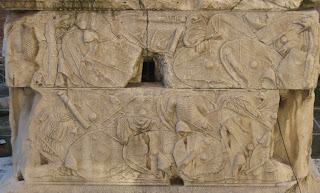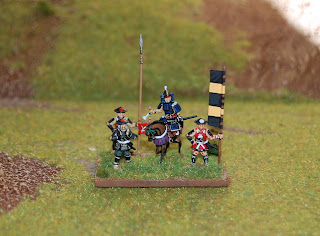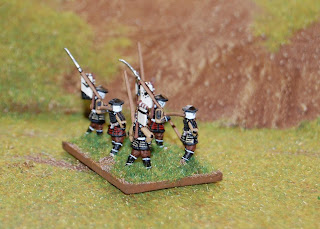Este es el general del clan imaginario Gôho, Gôho Ujimaru, rodeado de todo su Estado Mayor en su hatamoto. En esta peana he preparado toda la parafernalia heráldica del clan, aunque faltan los nobori de las tropas de línea y sus sashimono.
- - -
This is the general of the imagi-nation clan Gôho, Gôho Ujimaru, surrounded by all his staff in the hatamoto. In the base I made all the heraldic items of the clan, except the nobori and sashimono of the infantry.
Gôjo Ujimaru está acompañado de sus generales, que le rodean, y su hermano, Gôjo Sametono, que porta su shashimono personal, verde con una flor
icyou, la flor del ginko, en amarillo. El mon del clan representa la luna llena. El Uma-jirushi, en negro, muestra el mon en blanco, mientras que en la demás heráldica aparece en negro: en el Maku o cortina y en el ko-uma-jirushi, un abanico. También tiene un hata-jirushi en el que aparece el
hi-no-maru, el sol naciente, con el nombre de Hachiman, el dios de la guerra. El
tsukaiban, samurai encargado de la escolta personal, lleva un horo negro con un shashimono blanco, ambos con el mon del clan. Por último, un fukinuki en blanco y negro, que he hecho enrollando un alambre una vez pegué y recorté los flecos.
- - -
Gôjo Ujimaru is escorted by his generals, that surruond him, and his brother, Gôjo Sametono, whose personal shashimono shows, in yellow and green, a icyou flower, the flower of the gingko tree. The clan's mon shows the full moon. The Uma-jurushi is in black, with the mon in white, while in the rest of the heraldry the mon is black, in white: in the Maku courtains, and in the ko-uma-jirushi, showing a war fan. Also there is a hata-jirushi with the hi-no-maru, the raising sun, and the name of Hachiman, the god of war. The tsukaiban, the guard samurai, wears a black horo and a white sashimono, both with the clan's mon. Lastly, a fukinuki, in white and black, that I made rolling up the a wire after gluing and cutting the fringes.






























































